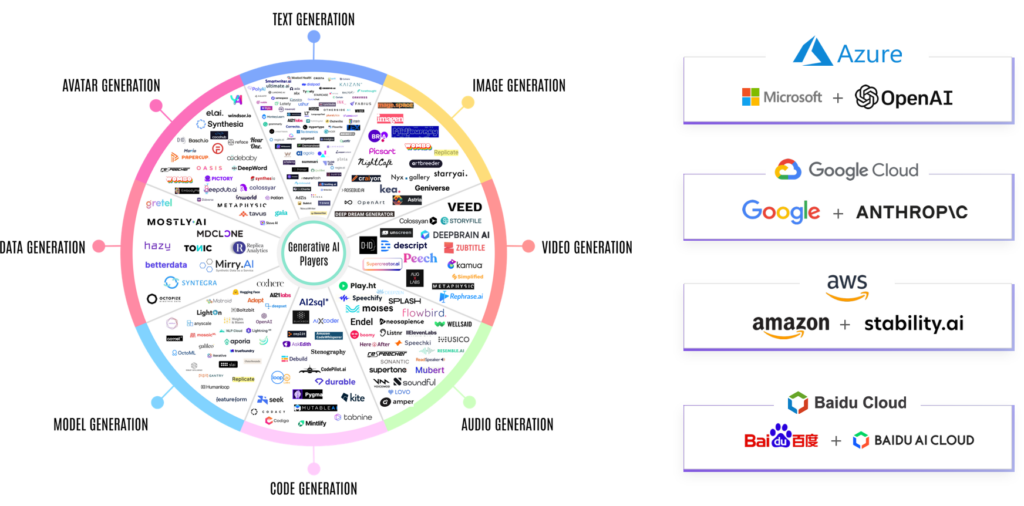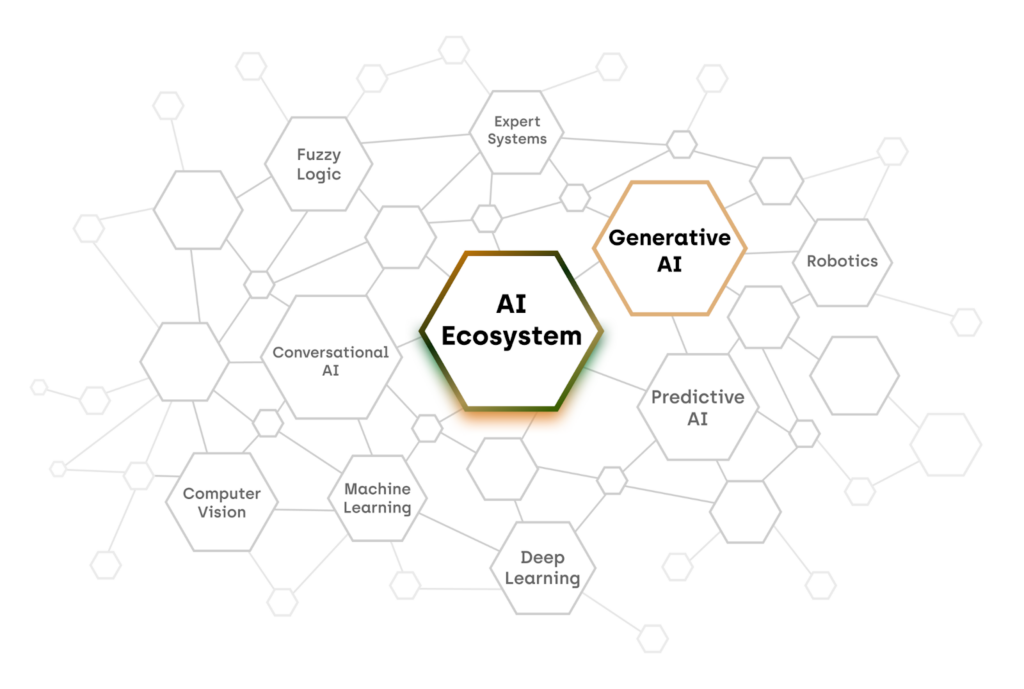A Humans’ Guide to Demystify AI

ChatGPT, Bard, Midjourney, RunwayML, and most importantly, deep fake Drake — AI is everywhere and is shape-shifting several times a day. The pace of change is overwhelming. Since the scale of impact is not short on hype (i.e., “AI is going to be bigger than the internet” or “AI could destroy humanity next week”), it’s hard to establish a framework within which to place every mind-boggling piece of news or earth-shattering announcement.
To this end, we have produced two charts and a framework that function as basic ecosystem maps and will hopefully be useful reference tools (at least for the next couple of weeks).
Chart No.1 – The Generative AI Ecosystem
The last six months have seen an explosion of interest in Gen AI. This has most visibly been expressed through the success of Chat GPT, which reached 100 million users in two months, comfortably becoming the fastest-growing app of all time.
However, text generation is only one of several fields of Gen AI. Within our chart, we have attempted to map the key startups in each of the Gen AI disciplines. (For disclaimers, see above.) Our team has organized the landscape into eight key categories of Generative AI that brands are looking to leverage: text, image, video, audio, code, data, modeling, and avatar generation. We’ve combed through hundreds of emerging platforms and selected key leaders and partners who are making the biggest impact in each sector. An important nuance of note is that many of the key platforms have signed partnerships or investment deals with legacy tech companies.
These partnerships will culminate in a wave of new user experiences within well-known business tools from Microsoft, Google, and AWS. But we also anticipate that these partnerships will come with assurances that the billions of content productions will be processed and stored on these partner cloud servers.

Text
The best-known segment, exemplified by Open AI’s ChatGPT and Google’s LaMDA (Language Model for Dialogue Applications), sit on top of LLM’s (Large Language Models), which are large datasets on which the software is trained. These models also generate software code and data (see below), and the LLMs behind them power many of the other apps in the ecosystem.
Image
Generative image AIs can create art from scratch, and modify or add to pictures. Well-known image AIs include Midjourney and Lensa. Neural Radiance Fields (AI NeRF) are a new type of AI that produces 3D models from 2D pictures.
Video
Video Generative AI can include dubbing, creating scenes from scratch, and transforming existing videos into new ones: storyboarding, masking, rendering, and more.
Audio
Generative audio AI creates media from scratch using synthetic voice technology. The ability to create, convert, edit, dub, and translate audio, is going to be the underlying media element of much of what we all create. In the future, we might be typing into virtual keyboards, but we’ll also be utilizing voice in a much more comprehensive way, to augment our experience of technology.
Code
Many of the well-known platforms in text generation have gone through extensive training on software code in an effort to better shape their transformer logic. With great code training comes the ability to generate code. Technologists are finding that generative code platforms are able to successfully originate, edit, debug, and rewrite code, allowing tech teams to develop at 3-5x the speed they normally would.
Data
You can fashion synthetic data created by AI trained on real-world data sets. Generative AI can be trained to make variable data sets based on a specific volume of data you already have on your consumers or audience. You can also use Generative AI to clean, filter, identify, and fill in data and even explore new insights.
Generative AI can model data sets like audience behavior, product design, and physical retail environments. The ability to connect generative tools to data and modeling systems is going to revolutionize the ways in which businesses interact with their customers..
Model
Large brands and organizations have been undergoing data initiatives for years, trying to make sense of the mountains of data they have coming in from audience and consumer engagements. Not only will AI tools make it easier to process and understand this data, but they will allow users to originate, synthesize, translate, and uniquely assess data models. Creative data modeling at scale may fundamentally change how brands can look at their consumer and product data.
Avatar
Avatar generation is the production of virtual beings for fast creation and deployment of virtual and interactive characters in physical and virtual environments. Use DID or Synthesia to upload a picture of yourself, or you can pick an avatar off the shelf. They auto-connect to ChatGPT and other tools, so you have a fully conversational avatar spun up in a matter of minutes.
The ability to have generativity-designed NPCs in virtual worlds and games drastically changes engagement in gaming platforms. But Generative AI avatars are more than just looks; that’s where the conversation around Cloud Edge comes into play. AWS Sim Space Weaver is one large-scale service that allows you to have almost up to one million entities per instance.
Chart No. 2 – The overall AI ecosystem
Although the majority of recent news has surrounded Generative AI, Gen AI is only one of the pieces of a broader AI ecosystem. This chart maps out a few of the other components of AI, many of which brands have been using for years. The convergence of these AI tools with Generative AI is what makes this AI renaissance so exciting.





 Brandon Kaplan
Brandon Kaplan


